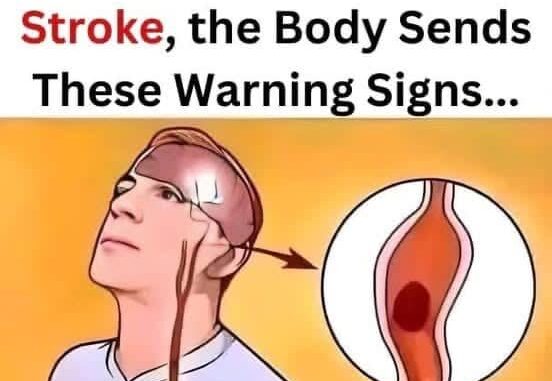
Some early warning signs of stroke may be numbness or weakness in your arms, legs, or face, confusion,or difficulty walking. A TIA can also be an indicator of a future stroke that may occur within three months.
The bottom line is that you must act as quickly as possible when you notice any symptoms of stroke to get the care you need.
You can also prepare for a potential stroke by knowing your risk factors,finding the closest stroke center to you, and having a list of medications ready for healthcare providers.
Below are details of 7 warning signs of an impending stroke.
1.1. Severe headache
Headaches are a sign of many different health problems. However, if the headache comes suddenly, is severe and has no known cause, this could be one of the 7 early warning signs of a stroke . The headache area in stroke patients tends to be widespread and the pain is often quite long.

Severe headache is one of the 7 warning signs of an impending stroke a week in advance
1.2. Decreased vision
People who have had a stroke often experience vision problems around the time before the stroke occurs. Therefore, this is also considered one of the 7 warning signs of an impending stroke a week in advance .
Vision problems in stroke patients arise from a lack of blood supply to the brain. This causes abnormalities such as:
– Blurred vision or loss of vision.
– Near or far vision is worse than normal.
– Vision has the appearance of dark shadows or blind spots.
1.3. Dizziness and loss of balance
One of the 7 warning signs of an impending stroke a week in advance that you need to remember is loss of balance and dizziness. This is the result of interrupted blood circulation in the central nervous system.
People with stroke often have signs of loss of balance such as:
– Dizzy, dizzy.
– Difficulty maintaining balance when standing normally, difficulty walking.
– Feeling nauseous or faint.
1.4. Weakness in limbs
Before a stroke occurs, the patient is also very likely to experience numbness or weakness on one side of the body. This sign is due to the brain being deprived of oxygen and blood.
In this warning sign of an impending stroke, the patient will have the following symptoms:
– One side of the body, most commonly in the legs, arms, or face, feels numb, weak, and has difficulty moving.
– Difficulty moving or lifting heavy objects.
– Feeling like pins and needles or loss of sensation.
1.5. Difficulty speaking or understanding what others say
A stroke can affect the area of the brain that controls language, causing the patient to suddenly have difficulty speaking and understanding what others are saying. Specifically, the patient will experience:
– Stuttering, difficulty pronouncing or loss of ability to speak.
– Difficulty or inability to understand what others say.
– Confused and can’t remember words to express.

Numbness and weakness in the arms are also considered early warning signs of stroke.
1.6. Temporary memory loss
Short-term memory loss can be on the list of 7 warning signs of an impending stroke a week in advance because blood flow to the parts of the brain responsible for memory is reduced. This causes conditions such as:
– Forgetting recent events or important information.
– Difficulty remembering names of people or places.
– Feeling confused and uncertain about time and place.
1.7. Tired , lack of vitality
Feeling tired and lacking vitality for a long time can be a warning sign of a stroke due to the brain not receiving enough oxygen and nutrients. At that time, the patient will experience:
– Constant fatigue without being able to explain the reason.
– Pale skin.
– Lack of energy and no motivation to work.
– Often sleepy, poor concentration.
What to do when there are warning signs of a stroke?
Proper and quick first aid helps minimize damage to stroke victims.
Regardless of the symptoms of the 7 warning signs of an impending stroke mentioned above, patients should immediately go to a medical facility to undergo the necessary examinations.
Specifically, what people with early warning signs of stroke need to do is:
Time is the decisive factor for the effectiveness of stroke treatment. Every minute that passes and misses the golden stroke time, the number of brain cells that die increases, the damage becomes more difficult to recover.
– Place the patient on his side
Place the patient in a lying position with the head elevated 30 – 45 degrees to keep the airway clear and avoid the risk of suffocation.
– Keep the patient stable
Keep the patient in a quiet space and if the patient falls, do not try to move them.
Dress the patient in loose, cool clothing or loosen their clothing. If the patient is having a seizure, place a chopstick wrapped in a cloth across the mouth to prevent biting the tongue.
– Observe to fully remember symptoms
Record the time symptoms began and any changes in the patient’s condition. Provide this information to emergency medical personnel when they arrive.
– Do not let the patient eat or drink.
Do not give the patient food or drink to avoid choking or suffocation.
– Provide information on medical conditions and drug use
Have information about the patient’s medical history and current medications ready to provide to medical staff.
– Do not arbitrarily apply folk methods (such as pricking the finger or toe with a needle, acupressure, acupuncture, scraping, cutting, etc.) because they are even more dangerous.
Quick and accurate action can make a big difference in a stroke patient’s recovery. So, as soon as you spot any of these 7 warning signs of an impending stroke,